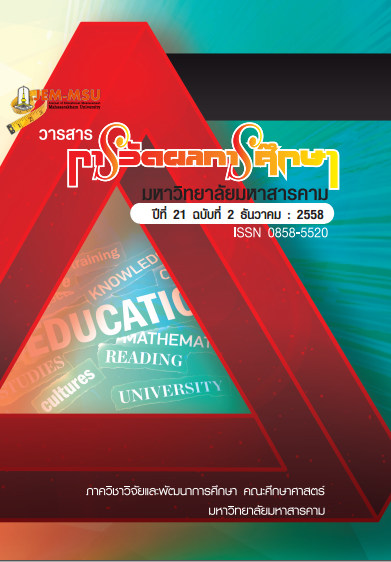Development of an Evaluation Model of Analytical Growth for Mattayomsuksa 3 Students
Main Article Content
Abstract
The purposes of this research were: 1) to study factors of an analytical
growth evaluation for Mattayomsuksa 3 students; 2) to try the following growthassessment methods: a) observed Different Score method (DS), b) Relative gain Score
method (RG), and c) a method developed by the researcher; 3) to study the quality of
growth assessment by the researcher-developed method; and 4) to study the effectiveness
of an evaluation model of analytical growth for Mattayomsuksa 3 students. The study
of factors of an analytical growth evaluation focuses on the Mattayomsuksa 3 teachers
who are under the jurisdiction of the NakhonPhanom Primary Educational Service Area
Office 1 and the Secondary Educational Service Area Office 22, totaling 513 teachers.
Nine of these teachers plus 266 Mattayomsuksa 3 students were selected to try the
growth-assessment methods. The study of the effectiveness of an evaluation model of
analytical growth focuses on a selected group of 47 teachers and supervisors of the NakhonPhanom Primary Educational Service Area Office 1 and 2 and the Secondary
Educational Service Area Office 22. Instruments used in the study consisted of a
questionnaire, analytical testing, and interviews. The data collected was analyzed
based on descriptive statistics, factor analysis and content analysis, plus use of the
Monte Carlo technique by Mplus version 6.21 and Lisrel version 8.72 to analyze the
latent growth curve model. In addition, I analyzed criterion-related validity by using
the Pearson coefficient, and measurement error. The research results indicated that:
1. Four factors of an analytical growth evaluation for Mattayomsuksa 3
students were measured by 14 indicators. The 4 factors included a) planning, b)
specification of growth-assessment methods, 3) feedback of results, and 4) a growth
evaluation report.
2. No difference in results of growth-assessment methods usage was
calculated. The analytical testing was convenient, efficient and standard for analytical
growth assessment. The results showed that the growth score from the Relative Gain
Score (RG), Different gain Score (DS) and research-developed method ranged from high
to low, respectively.
3. Regarding the quality of the researcher-developed method, I found the
following: 1) When the basic coefficients were [0, 0.2, 0.4, 0.6, 0.8], the criterion-related
validity was low- and medium-level in the 3 and 4 time-point-measurements, respectively.
In the 5 time-point-measurement, with mean of level (ML) at 35 and mean of slope
(MS) at -0.15 and 1.20, the criterion-related validity was medium-level. For other
measurements, the criterion-related validity was low-level. 2) When the basic coefficients
were [0, 1, 2, 3, 4], the criterion-related validity was low medium level in the 3 timepoint-measurement. For other measurements, the criterion-related validity was lowlevel, and there was low measurement error in every situation and every condition of
measurement.
4. The effectiveness of an evaluation model of analytical growth for
Mattayomsuksa 3 students was good, in terms of utility, feasibility, propriety and
accuracy. If this evaluation model is supported by policy, and if teachers are interested
in it, it will be very successful in practice.
Article Details
The content and information contained in the published article in the Journal of Educational Measurement Mahasarakham University represent the opinions and responsibilities of the authors directly. The editorial board of the journal is not necessarily in agreement with or responsible for any of the content.
The articles, data, content, images, etc. that have been published in the Journal of Educational Measurement Mahasarakham University are copyrighted by the journal. If any individual or organization wishes to reproduce or perform any actions involving the entirety or any part of the content, they must obtain written permission from the Journal of Educational Measurement Mahasarakham University.


